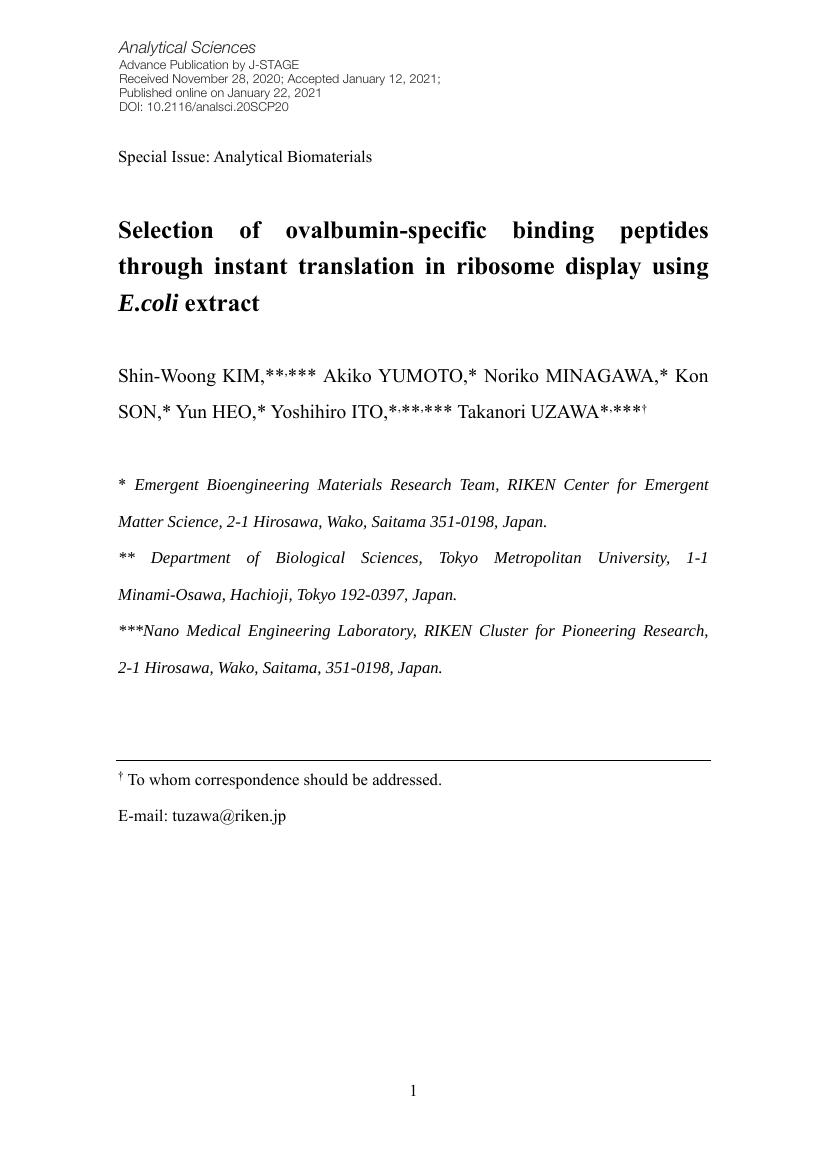- 著者
- Hideo Izawa Toshiko Yoshida Toshimi Ikegame Kazuhiro P. Izawa Yoshihiro Ito Hideo Okamura Naohiko Osada Shintaro Kinugawa Takuro Kubozono Yuji Kono Kiyonori Kobayashi Kazuhiko Nishigaki Taiki Higo Akihiro Hirashiki Yasushi Miyazawa Yuji Morio Masanobu Yanase Sumio Yamada Hisao Ikeda Shin-ichi Momomura Yasuki Kihara Kazuhiro Yamamoto Yoichi Goto Shigeru Makita the Japanese Association of Cardiac Rehabilitation Standard Cardiac Rehabilitation Program Planning Committee
- 出版者
- The Japanese Circulation Society
- 雑誌
- Circulation Journal (ISSN:13469843)
- 巻号頁・発行日
- pp.CJ-19-0670, (Released:2019-11-09)
- 参考文献数
- 21
- 被引用文献数
- 52
- 著者
- Morteza M. Saber Marziyeh Karimiavargani Takanori Uzawa Nilmini Hettiarachchi Michiaki Hamada Yoshihiro Ito Naruya Saitou
- 出版者
- The Genetics Society of Japan
- 雑誌
- Genes & Genetic Systems (ISSN:13417568)
- 巻号頁・発行日
- pp.20-00012, (Released:2021-03-24)
- 参考文献数
- 56
- 被引用文献数
- 4
Down syndrome in humans is caused by trisomy of chromosome 21. DSCR4 (Down syndrome critical region 4) is a de novo-originated protein-coding gene present only in human chromosome 21 and its homologous chromosomes in apes. Despite being located in a medically critical genomic region and an abundance of evidence indicating its functionality, the roles of DSCR4 in human cells are unknown. We used a bioinformatic approach to infer the biological importance and cellular roles of this gene. Our analysis indicates that DSCR4 is likely involved in the regulation of interconnected biological pathways related to cell migration, coagulation and the immune system. We also showed that these predicted biological functions are consistent with tissue-specific expression of DSCR4 in migratory immune system leukocyte cells and neural crest cells (NCCs) that shape facial morphology in the human embryo. The immune system and NCCs are known to be affected in Down syndrome individuals, who suffer from DSCR4 misregulation, which further supports our findings. Providing evidence for the critical roles of DSCR4 in human cells, our findings establish the basis for further experimental investigations that will be necessary to confirm the roles of DSCR4 in the etiology of Down syndrome.
2 0 0 0 OA Effects of assigning physical therapists exclusively to the acute-phase stroke patient ward
- 著者
- Yuichi Nishikawa Kazuhiko Hirata Yoshihiro Ito Kazuyuki Ueda Hiroaki Kimura
- 出版者
- The Society of Physical Therapy Science
- 雑誌
- Journal of Physical Therapy Science (ISSN:09155287)
- 巻号頁・発行日
- vol.34, no.3, pp.225-229, 2022 (Released:2022-03-14)
- 参考文献数
- 15
[Purpose] In April 2014, an additional health insurance system aiming to maintain or improve activities of daily living levels was newly established by the Japanese government. The purpose of this study was to determine the influence of this new medical system for rehabilitation on patient management (e.g., activities of daily living level and length of hospital stay) in an acute-phase stroke patient ward. [Participants and Methods] All patients were admitted to the stroke patient ward in our hospital and were registered between January 2012 and December 2019. We assessed the differences in the time to initiation of rehabilitation, length of hospitalization, implementation rate of rehabilitation, and Barthel Index between the period before the start of the new medical system (Prior period) and after this system was started (Post period). [Results] Significant improvements were observed in the initiation of rehabilitation and the difference in the Barthel Index scores after the start of the new medical system. Although the length of hospitalization and implementation rate of rehabilitation did not differ significantly, both indicators gradually improved after the start of the new system. [Conclusion] Our results suggest that the new medical system for rehabilitation is beneficial for patient management in the acute-phase stroke patient ward.
- 著者
- Shin-Woong KIM Akiko YUMOTO Noriko MINAGAWA Kon SON Yun HEO Yoshihiro ITO Takanori UZAWA
- 出版者
- The Japan Society for Analytical Chemistry
- 雑誌
- Analytical Sciences (ISSN:09106340)
- 巻号頁・発行日
- pp.20SCP20, (Released:2021-01-22)
